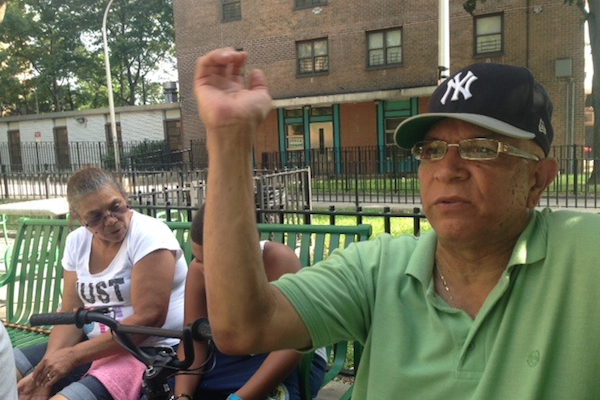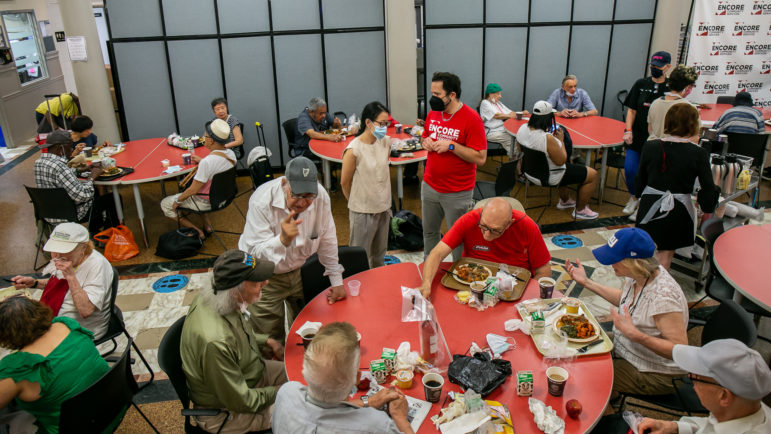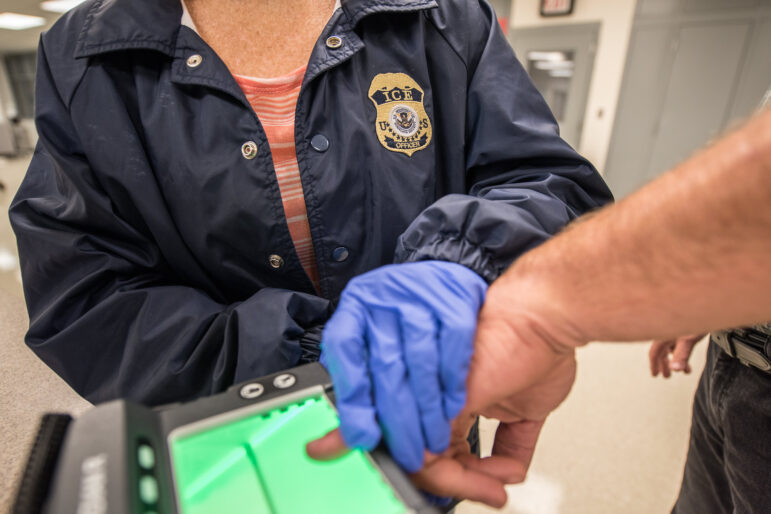
Photo by: Ken Thorbourne
Oscar Cruz, a resident at the Webster Morrisania Houses in the South Bronx, says his apartment is filled with mold and four of the five family members who live there have respiratory problems.
It’s been six months since two community groups and the New York Housing Authority signed a landmark settlement agreement to address mold and moisture problems in public housing units and three months since a federal judge ordered the new rules into effect.
Yet, Blanche Moore’s bathroom inside her eighth-floor apartment at the DeWitt Clinton Houses in East Harlem remains a textbook case for how to grow mold.
The air is thick, moist, and still. As of the first week of this month, a swath of the ceiling above her tub was covered with splotches of black mold, the fungus that can cause severe respiratory problems, including asthma.
There’s so much moisture in her bathroom that when she takes a shower the plaster on the ceiling above the tub loosens and drops on her head.
“I usually sweep it all down so it doesn’t come down on me,” says Moore, 61, a former home attendant.
Moore, who is on medication for asthma, says she first complained to her landlord, the New York City Housing Authority, about the mold six years ago. “They just came and painted over it. They said to keep the [bathroom] vent,” which itself appeared to be caked in mold, “cleared out.”
The new rules compel NYCHA to complete simple mold and moisture repairs within seven days and more complex ones within 15 days. In all cases, NYCHA has to fix the underlying problem that is causing the moisture and not just paint or plaster over the problem. There is no timetable in the agreement for repairs that require capital improvements such as a new roof.
Slow progress seen
The leaders of South Bronx Churches and Manhattan Together – the two members of the umbrella organization Metro IAF that entered the settlement with NYCHA — didn’t expect NYCHA, which houses more than 400,000 people in 179,000 units, to become a model citizen for addressing mold concerns overnight, but they also are not satisfied with the time NYCHA is apparently taking to change direction.
“The settlement was a win on paper,” says the Rev. Francis Skelly of the Immaculate Conception Church, a leader of the South Bronx Churches. “So far we haven’t seen a change in procedure. Some of the plaintiffs are telling us the same thing, (NYCHA workers) painting over the mold.
“However, Metro IAF leaders who live in public housing have started to see some improvement in other areas like cleaning of outdoor areas and hallways in a few developments,” Skelly says. “We hope this continues and spreads to other developments and other areas like dealing with mold and moisture.”
Leah Goodridge, attorney with the nonprofit Urban Justice Center — which on July 2 reached a court settlement requiring NYCHA to make more than 100 repairs at the 1,700-resident DeWitt Clinton Houses — is “optimistic” NYCHA will improve its response to mold and moisture problems. But those changes have not taken hold as yet, she says.
“These issues have been going on for such a long time. It’s going to take tenants a long time to feel the change,” Goodridge says. “For these tenants in this (Urban Justice Center’s) lawsuit … there hasn’t been any seven days or 15 days.”
NYCHA gearing up
Shola Olatoye, the housing advocate Mayor Bill de Blasio appointed NYCHA chairwoman in February, has apparently embraced the mold and moisture settlement and her agency says it is gearing up to deliver.
In a statement to City Limits, NYCHA says it has “rolled out additional training and procedures to aid in the assessment of mold and the conditions that foster it” and has “partnered with Rutgers University to train supervisory staff on how to correctly identify whether there is mold … how to determine the root cause of mold and create a plan to address the cause.”
In addition, NYCHA will “contact residents who have more than 10 square feet of mold in their apartment within 60 days of the mold removal” and “some portion of the work will be inspected for quality assurance.”
“As a landlord, NYCHA is committed to improving the quality of life of its residents and the state of its properties,” the statement continues.
“Unfortunately, there are some terrible conditions persisting in some of NYCHA’s nearly 179,000 units. Addressing these conditions is a huge undertaking and one we continue to address despite diminishing federal funds, legal tangles and old buildings. We are working hard to accelerate repairs. We’ve made substantial progress, with more to do, reducing our backlog to 80,000 from more than 400,000 work orders, and reducing wait times.”
A family with lung trouble
Oscar Cruz, a tenant at the Webster Morrisania Houses in the South Bronx since 1980, is tired of waiting on NYCHA to fix a water leak in his apartment. When the Cruz family first moved in, they lived on the 11th floor. Because his son Jason was sickly, and Oscar had to physically carry him up 11 flights of stairs when the elevators were out, which was often, the family requested and was given a first floor apartment in 2000.
That’s when Jason’s heath, along with everyone else’s in the family, got worse.
“Every year, two or three times, the apartment would flood,” says Cruz, a member of St. Augustine & Our Lady of Victory Church in the South Bronx, part of South Bronx Churches. “We had to throw out three sets of furniture.”
The water pours down from the ceiling between the living room and the kitchen, Cruz says. Mold, which can cause asthma and other respiratory illnesses, became visible in one of the five-bedroom apartment’s two bathrooms. But Cruz is convinced the downpours, the last one of which occurred in April, has fostered mold inside several walls.
“[NYCHA] said the problem was a neighbor’s bathroom wall and they fixed that. On May 22, housing came and spread a chemical in the bathroom to kill the mold. I told them I guarantee you this is not going to solve the problem,” Cruz says. “Today (July 3), the mold came back.”
Of the five people who live in the apartment, three — Oscar’s wife Felipa, their daughter, Jennifer, and 11-year-old grandson Jeans Oscar Jr. — have asthma. And last year, Cruz says he was diagnosed with a respiratory illness.
But his emotions are most raw when he talks about his son Jason, who died in August 2008 at 23. Cruz, says all of Jason’s symptoms got worse when the family moved into the first-floor apartment.
“He (Jason) had to be on oxygen,” Cruz says. “At the hospital, he was okay when they discharged him. But he’d be here not even a day and he couldn’t breathe … He went from a cane, to a wheelchair, to a motorized wheelchair … That was my baby.”
Paint doesn’t help
Bill Sothern is president of Microecologies, a Manhattan firm that has conducted thousands of environmental investigations over the past 20 years. .
Microecologies carried out inspections for the attorneys who represented Metro IAF in federal lawsuit against NYCHA that led to the settlement, and he helped write the new protocols NYCHA repair workers must now follow when dealing with mold and moisture problems.
According to Sothern, the fact that the walls inside NYCHA developments are mostly concrete and plaster, which don’t support growth of the fungus, “works to the advantage of NYCHA residents to prevent the worse kind of mold (growth).”
“But the painted surface over concrete provides the ideal nutrient to promote the growth of Aspergillus and Penicillium,” the potentially asthma-inducing types of mold most commonly found in public housing, “when the paint is subject to leaks and recurrent moisture,” he explains. “What NYCHA was doing was scraping the mold and painting the surfaces without addressing the underlying cause. Understandably, the mold would reappear.”
Citing government studies, Sothern notes the asthma rate in the U.S. is between 6 and 7 percent, and 13.5 percent in New York City. But in East Harlem, where there is a high density of public housing, the asthma rate is 19.6 percent. Extrapolating from that data, Sothern estimates the asthma rate among public housing tenants is 20 to 25 percent. NYCHA does not track that statistic.
Even though the settlement comes with it a hefty price-tag, Sothern argues it’s a good investment.
“It requires funding to open up walls, to correct plumbing problems, to reinsulate walls, to deal with façade problems,” he says. “The payback will be very high because right now public housing tenants with asthma go the emergency room. And who pays for that? The taxpayer. This will be a very high return on investment.”
The organizing challenge
Community groups are beginning to spread the word about the mold and moisture settlement. Monique George, the NYC organizing director for Community Voices Heard, a group with a long history of working in public housing, says CVH has done “mold surveys” at five buildings in two public housing developments, and plans to conduct hundreds more.
“We’ve been door knocking,” George says. “Step two will be to actually document the cases.”
Manhattan Together, South Bronx Churches, along with Metro IAF’s East Brooklyn Congregations, plan to engage thousands of public housing residents across the city on this issue.
“This (settlement) is a tool for us,” says Michael Stanley, lead organizer for Manhattan Together and South Bronx Churches. “It was always clear to us that this settlement by itself would not be enough … We have to make sure the rules are followed.”








